Organisational Communication Analysis: Mr. Fishy Report
VerifiedAdded on 2021/02/19
|8
|1926
|101
Report
AI Summary
This report examines the communication practices within Mr Fishy, a UK-based organization, identifying various barriers such as language, psychological, attitudinal, and physical challenges. It then proposes strategies to overcome these barriers, including training programs, clear messaging, improved communication channels, leadership development, and employee feedback. The report further applies organizational communication theories, such as Weber's classic organizational theory of fixed structures and Tompkins and Cheney's organizational control theory, to enhance communication effectiveness. The conclusion emphasizes the importance of effective communication structures for achieving organizational goals, motivating employees, and facilitating informed decision-making. It also highlights the utility of various organizational communication theories in improving communication strategies and information flow.
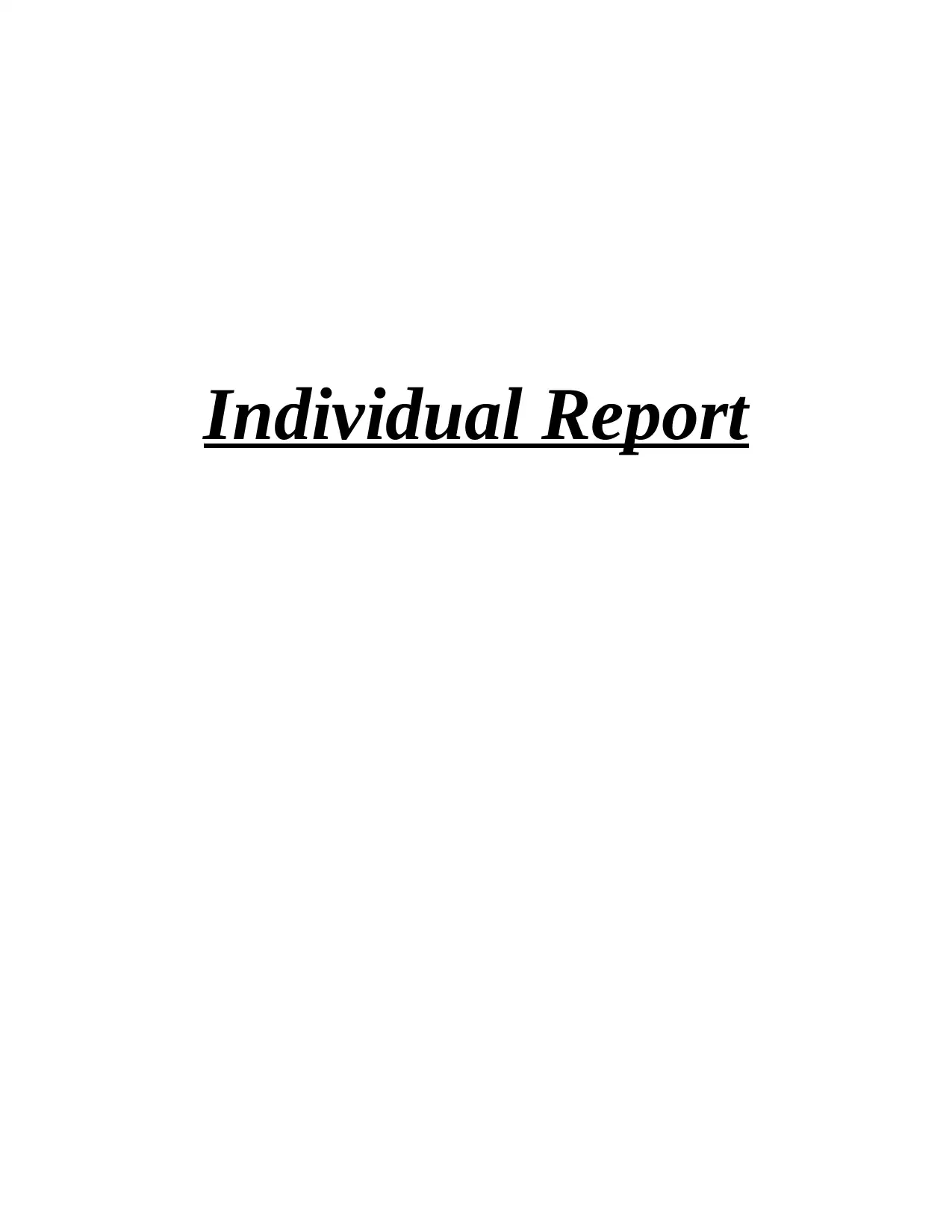
Individual Report
Paraphrase This Document
Need a fresh take? Get an instant paraphrase of this document with our AI Paraphraser
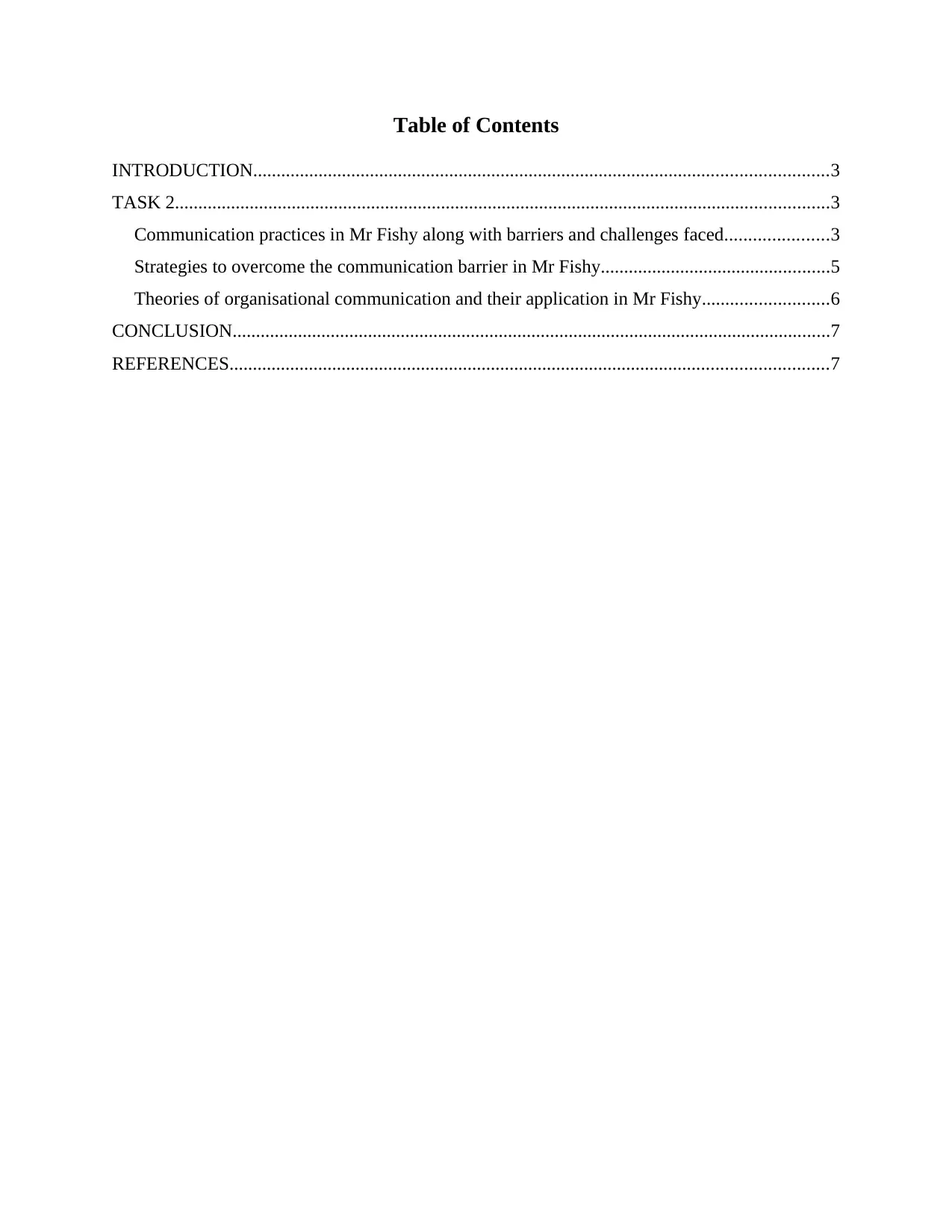
Table of Contents
INTRODUCTION...........................................................................................................................3
TASK 2............................................................................................................................................3
Communication practices in Mr Fishy along with barriers and challenges faced......................3
Strategies to overcome the communication barrier in Mr Fishy.................................................5
Theories of organisational communication and their application in Mr Fishy...........................6
CONCLUSION................................................................................................................................7
REFERENCES................................................................................................................................7
INTRODUCTION...........................................................................................................................3
TASK 2............................................................................................................................................3
Communication practices in Mr Fishy along with barriers and challenges faced......................3
Strategies to overcome the communication barrier in Mr Fishy.................................................5
Theories of organisational communication and their application in Mr Fishy...........................6
CONCLUSION................................................................................................................................7
REFERENCES................................................................................................................................7
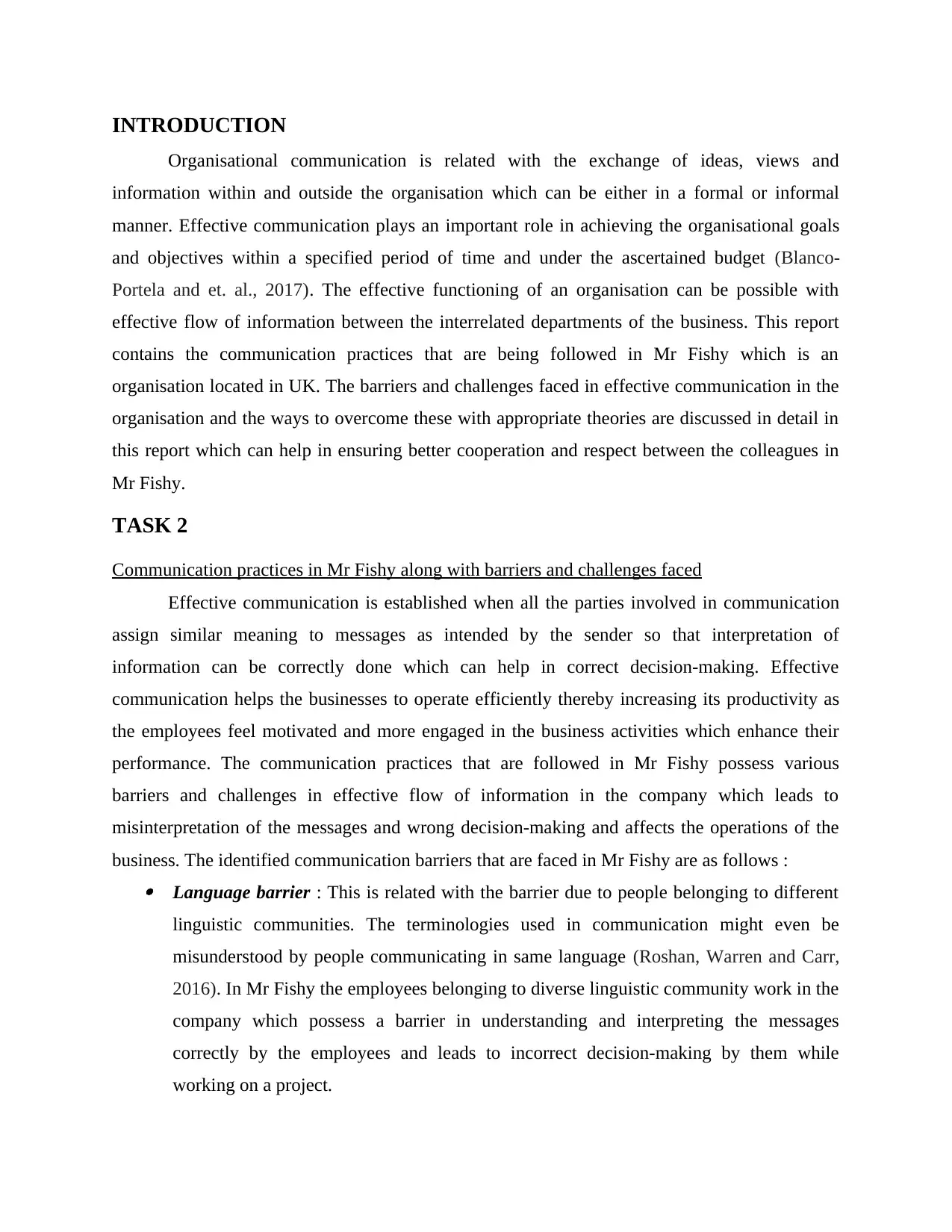
INTRODUCTION
Organisational communication is related with the exchange of ideas, views and
information within and outside the organisation which can be either in a formal or informal
manner. Effective communication plays an important role in achieving the organisational goals
and objectives within a specified period of time and under the ascertained budget (Blanco-
Portela and et. al., 2017). The effective functioning of an organisation can be possible with
effective flow of information between the interrelated departments of the business. This report
contains the communication practices that are being followed in Mr Fishy which is an
organisation located in UK. The barriers and challenges faced in effective communication in the
organisation and the ways to overcome these with appropriate theories are discussed in detail in
this report which can help in ensuring better cooperation and respect between the colleagues in
Mr Fishy.
TASK 2
Communication practices in Mr Fishy along with barriers and challenges faced
Effective communication is established when all the parties involved in communication
assign similar meaning to messages as intended by the sender so that interpretation of
information can be correctly done which can help in correct decision-making. Effective
communication helps the businesses to operate efficiently thereby increasing its productivity as
the employees feel motivated and more engaged in the business activities which enhance their
performance. The communication practices that are followed in Mr Fishy possess various
barriers and challenges in effective flow of information in the company which leads to
misinterpretation of the messages and wrong decision-making and affects the operations of the
business. The identified communication barriers that are faced in Mr Fishy are as follows : Language barrier : This is related with the barrier due to people belonging to different
linguistic communities. The terminologies used in communication might even be
misunderstood by people communicating in same language (Roshan, Warren and Carr,
2016). In Mr Fishy the employees belonging to diverse linguistic community work in the
company which possess a barrier in understanding and interpreting the messages
correctly by the employees and leads to incorrect decision-making by them while
working on a project.
Organisational communication is related with the exchange of ideas, views and
information within and outside the organisation which can be either in a formal or informal
manner. Effective communication plays an important role in achieving the organisational goals
and objectives within a specified period of time and under the ascertained budget (Blanco-
Portela and et. al., 2017). The effective functioning of an organisation can be possible with
effective flow of information between the interrelated departments of the business. This report
contains the communication practices that are being followed in Mr Fishy which is an
organisation located in UK. The barriers and challenges faced in effective communication in the
organisation and the ways to overcome these with appropriate theories are discussed in detail in
this report which can help in ensuring better cooperation and respect between the colleagues in
Mr Fishy.
TASK 2
Communication practices in Mr Fishy along with barriers and challenges faced
Effective communication is established when all the parties involved in communication
assign similar meaning to messages as intended by the sender so that interpretation of
information can be correctly done which can help in correct decision-making. Effective
communication helps the businesses to operate efficiently thereby increasing its productivity as
the employees feel motivated and more engaged in the business activities which enhance their
performance. The communication practices that are followed in Mr Fishy possess various
barriers and challenges in effective flow of information in the company which leads to
misinterpretation of the messages and wrong decision-making and affects the operations of the
business. The identified communication barriers that are faced in Mr Fishy are as follows : Language barrier : This is related with the barrier due to people belonging to different
linguistic communities. The terminologies used in communication might even be
misunderstood by people communicating in same language (Roshan, Warren and Carr,
2016). In Mr Fishy the employees belonging to diverse linguistic community work in the
company which possess a barrier in understanding and interpreting the messages
correctly by the employees and leads to incorrect decision-making by them while
working on a project.
⊘ This is a preview!⊘
Do you want full access?
Subscribe today to unlock all pages.

Trusted by 1+ million students worldwide
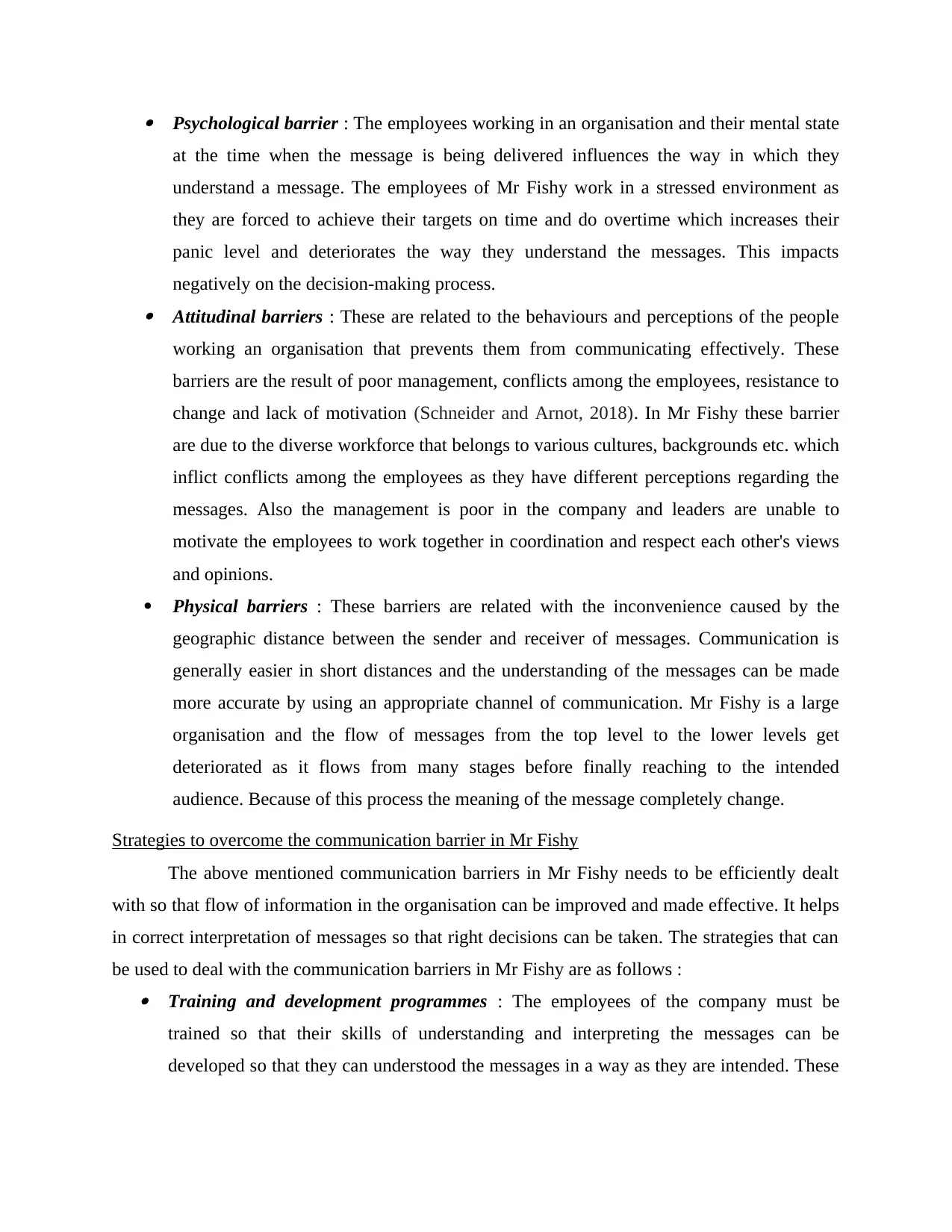
Psychological barrier : The employees working in an organisation and their mental state
at the time when the message is being delivered influences the way in which they
understand a message. The employees of Mr Fishy work in a stressed environment as
they are forced to achieve their targets on time and do overtime which increases their
panic level and deteriorates the way they understand the messages. This impacts
negatively on the decision-making process. Attitudinal barriers : These are related to the behaviours and perceptions of the people
working an organisation that prevents them from communicating effectively. These
barriers are the result of poor management, conflicts among the employees, resistance to
change and lack of motivation (Schneider and Arnot, 2018). In Mr Fishy these barrier
are due to the diverse workforce that belongs to various cultures, backgrounds etc. which
inflict conflicts among the employees as they have different perceptions regarding the
messages. Also the management is poor in the company and leaders are unable to
motivate the employees to work together in coordination and respect each other's views
and opinions.
Physical barriers : These barriers are related with the inconvenience caused by the
geographic distance between the sender and receiver of messages. Communication is
generally easier in short distances and the understanding of the messages can be made
more accurate by using an appropriate channel of communication. Mr Fishy is a large
organisation and the flow of messages from the top level to the lower levels get
deteriorated as it flows from many stages before finally reaching to the intended
audience. Because of this process the meaning of the message completely change.
Strategies to overcome the communication barrier in Mr Fishy
The above mentioned communication barriers in Mr Fishy needs to be efficiently dealt
with so that flow of information in the organisation can be improved and made effective. It helps
in correct interpretation of messages so that right decisions can be taken. The strategies that can
be used to deal with the communication barriers in Mr Fishy are as follows : Training and development programmes : The employees of the company must be
trained so that their skills of understanding and interpreting the messages can be
developed so that they can understood the messages in a way as they are intended. These
at the time when the message is being delivered influences the way in which they
understand a message. The employees of Mr Fishy work in a stressed environment as
they are forced to achieve their targets on time and do overtime which increases their
panic level and deteriorates the way they understand the messages. This impacts
negatively on the decision-making process. Attitudinal barriers : These are related to the behaviours and perceptions of the people
working an organisation that prevents them from communicating effectively. These
barriers are the result of poor management, conflicts among the employees, resistance to
change and lack of motivation (Schneider and Arnot, 2018). In Mr Fishy these barrier
are due to the diverse workforce that belongs to various cultures, backgrounds etc. which
inflict conflicts among the employees as they have different perceptions regarding the
messages. Also the management is poor in the company and leaders are unable to
motivate the employees to work together in coordination and respect each other's views
and opinions.
Physical barriers : These barriers are related with the inconvenience caused by the
geographic distance between the sender and receiver of messages. Communication is
generally easier in short distances and the understanding of the messages can be made
more accurate by using an appropriate channel of communication. Mr Fishy is a large
organisation and the flow of messages from the top level to the lower levels get
deteriorated as it flows from many stages before finally reaching to the intended
audience. Because of this process the meaning of the message completely change.
Strategies to overcome the communication barrier in Mr Fishy
The above mentioned communication barriers in Mr Fishy needs to be efficiently dealt
with so that flow of information in the organisation can be improved and made effective. It helps
in correct interpretation of messages so that right decisions can be taken. The strategies that can
be used to deal with the communication barriers in Mr Fishy are as follows : Training and development programmes : The employees of the company must be
trained so that their skills of understanding and interpreting the messages can be
developed so that they can understood the messages in a way as they are intended. These
Paraphrase This Document
Need a fresh take? Get an instant paraphrase of this document with our AI Paraphraser
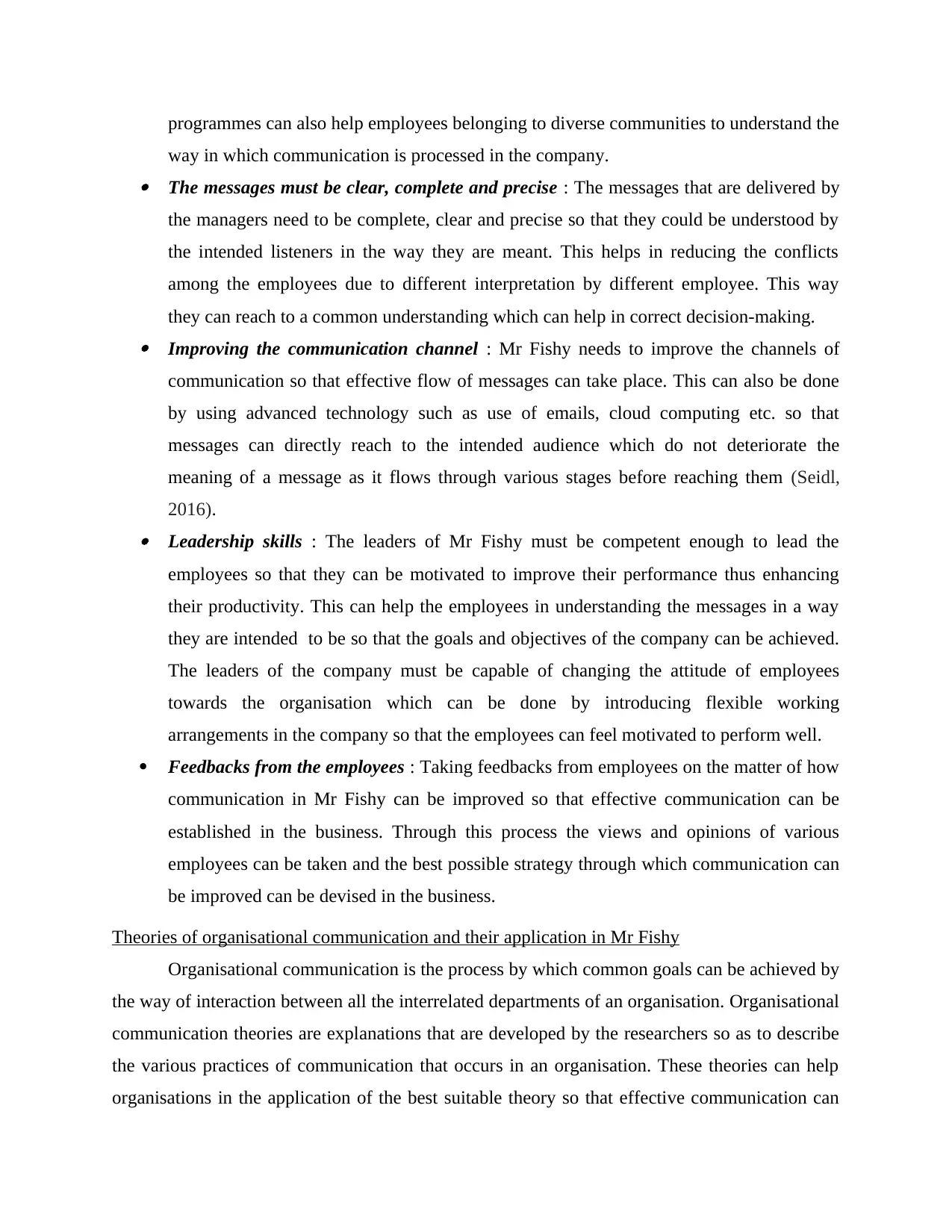
programmes can also help employees belonging to diverse communities to understand the
way in which communication is processed in the company. The messages must be clear, complete and precise : The messages that are delivered by
the managers need to be complete, clear and precise so that they could be understood by
the intended listeners in the way they are meant. This helps in reducing the conflicts
among the employees due to different interpretation by different employee. This way
they can reach to a common understanding which can help in correct decision-making. Improving the communication channel : Mr Fishy needs to improve the channels of
communication so that effective flow of messages can take place. This can also be done
by using advanced technology such as use of emails, cloud computing etc. so that
messages can directly reach to the intended audience which do not deteriorate the
meaning of a message as it flows through various stages before reaching them (Seidl,
2016). Leadership skills : The leaders of Mr Fishy must be competent enough to lead the
employees so that they can be motivated to improve their performance thus enhancing
their productivity. This can help the employees in understanding the messages in a way
they are intended to be so that the goals and objectives of the company can be achieved.
The leaders of the company must be capable of changing the attitude of employees
towards the organisation which can be done by introducing flexible working
arrangements in the company so that the employees can feel motivated to perform well.
Feedbacks from the employees : Taking feedbacks from employees on the matter of how
communication in Mr Fishy can be improved so that effective communication can be
established in the business. Through this process the views and opinions of various
employees can be taken and the best possible strategy through which communication can
be improved can be devised in the business.
Theories of organisational communication and their application in Mr Fishy
Organisational communication is the process by which common goals can be achieved by
the way of interaction between all the interrelated departments of an organisation. Organisational
communication theories are explanations that are developed by the researchers so as to describe
the various practices of communication that occurs in an organisation. These theories can help
organisations in the application of the best suitable theory so that effective communication can
way in which communication is processed in the company. The messages must be clear, complete and precise : The messages that are delivered by
the managers need to be complete, clear and precise so that they could be understood by
the intended listeners in the way they are meant. This helps in reducing the conflicts
among the employees due to different interpretation by different employee. This way
they can reach to a common understanding which can help in correct decision-making. Improving the communication channel : Mr Fishy needs to improve the channels of
communication so that effective flow of messages can take place. This can also be done
by using advanced technology such as use of emails, cloud computing etc. so that
messages can directly reach to the intended audience which do not deteriorate the
meaning of a message as it flows through various stages before reaching them (Seidl,
2016). Leadership skills : The leaders of Mr Fishy must be competent enough to lead the
employees so that they can be motivated to improve their performance thus enhancing
their productivity. This can help the employees in understanding the messages in a way
they are intended to be so that the goals and objectives of the company can be achieved.
The leaders of the company must be capable of changing the attitude of employees
towards the organisation which can be done by introducing flexible working
arrangements in the company so that the employees can feel motivated to perform well.
Feedbacks from the employees : Taking feedbacks from employees on the matter of how
communication in Mr Fishy can be improved so that effective communication can be
established in the business. Through this process the views and opinions of various
employees can be taken and the best possible strategy through which communication can
be improved can be devised in the business.
Theories of organisational communication and their application in Mr Fishy
Organisational communication is the process by which common goals can be achieved by
the way of interaction between all the interrelated departments of an organisation. Organisational
communication theories are explanations that are developed by the researchers so as to describe
the various practices of communication that occurs in an organisation. These theories can help
organisations in the application of the best suitable theory so that effective communication can
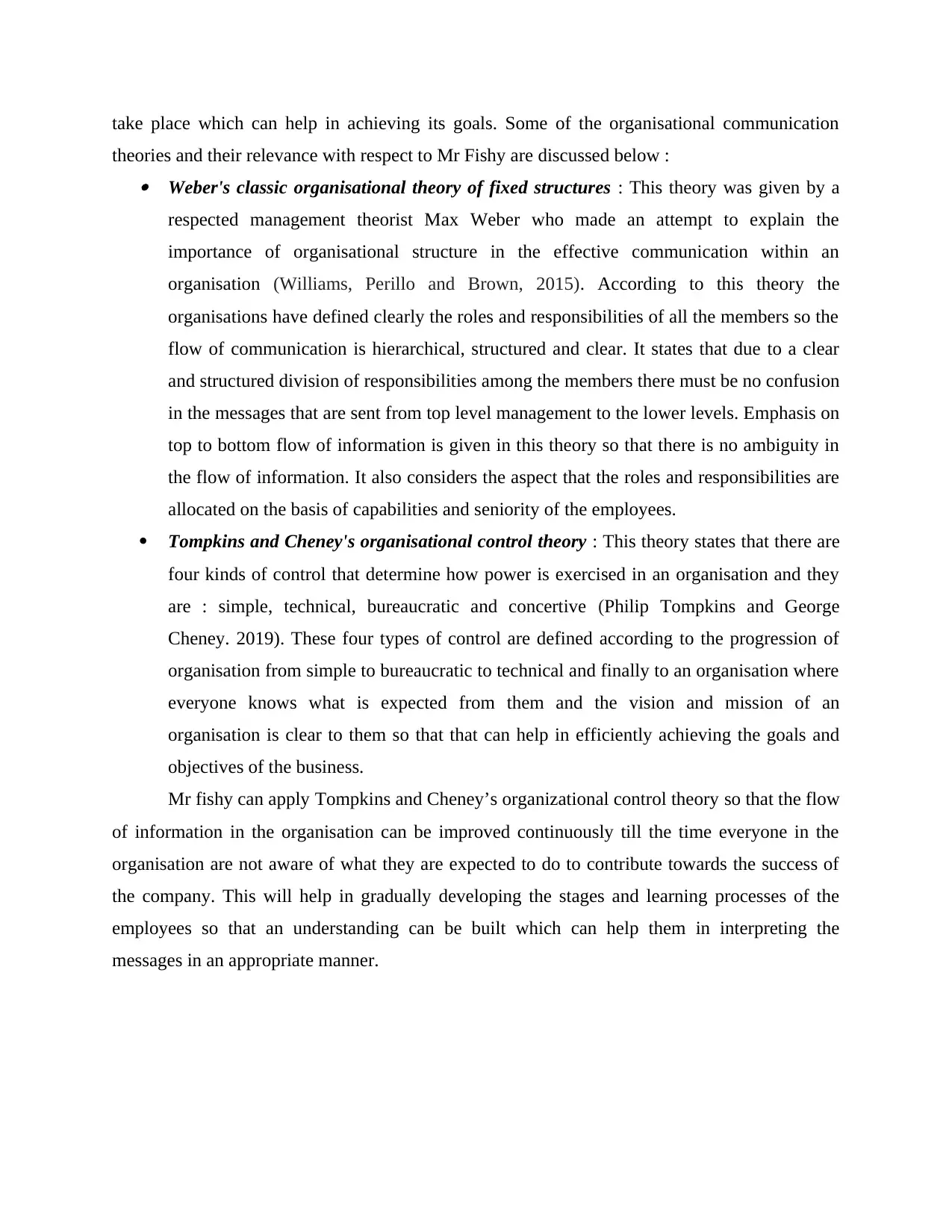
take place which can help in achieving its goals. Some of the organisational communication
theories and their relevance with respect to Mr Fishy are discussed below : Weber's classic organisational theory of fixed structures : This theory was given by a
respected management theorist Max Weber who made an attempt to explain the
importance of organisational structure in the effective communication within an
organisation (Williams, Perillo and Brown, 2015). According to this theory the
organisations have defined clearly the roles and responsibilities of all the members so the
flow of communication is hierarchical, structured and clear. It states that due to a clear
and structured division of responsibilities among the members there must be no confusion
in the messages that are sent from top level management to the lower levels. Emphasis on
top to bottom flow of information is given in this theory so that there is no ambiguity in
the flow of information. It also considers the aspect that the roles and responsibilities are
allocated on the basis of capabilities and seniority of the employees.
Tompkins and Cheney's organisational control theory : This theory states that there are
four kinds of control that determine how power is exercised in an organisation and they
are : simple, technical, bureaucratic and concertive (Philip Tompkins and George
Cheney. 2019). These four types of control are defined according to the progression of
organisation from simple to bureaucratic to technical and finally to an organisation where
everyone knows what is expected from them and the vision and mission of an
organisation is clear to them so that that can help in efficiently achieving the goals and
objectives of the business.
Mr fishy can apply Tompkins and Cheney’s organizational control theory so that the flow
of information in the organisation can be improved continuously till the time everyone in the
organisation are not aware of what they are expected to do to contribute towards the success of
the company. This will help in gradually developing the stages and learning processes of the
employees so that an understanding can be built which can help them in interpreting the
messages in an appropriate manner.
theories and their relevance with respect to Mr Fishy are discussed below : Weber's classic organisational theory of fixed structures : This theory was given by a
respected management theorist Max Weber who made an attempt to explain the
importance of organisational structure in the effective communication within an
organisation (Williams, Perillo and Brown, 2015). According to this theory the
organisations have defined clearly the roles and responsibilities of all the members so the
flow of communication is hierarchical, structured and clear. It states that due to a clear
and structured division of responsibilities among the members there must be no confusion
in the messages that are sent from top level management to the lower levels. Emphasis on
top to bottom flow of information is given in this theory so that there is no ambiguity in
the flow of information. It also considers the aspect that the roles and responsibilities are
allocated on the basis of capabilities and seniority of the employees.
Tompkins and Cheney's organisational control theory : This theory states that there are
four kinds of control that determine how power is exercised in an organisation and they
are : simple, technical, bureaucratic and concertive (Philip Tompkins and George
Cheney. 2019). These four types of control are defined according to the progression of
organisation from simple to bureaucratic to technical and finally to an organisation where
everyone knows what is expected from them and the vision and mission of an
organisation is clear to them so that that can help in efficiently achieving the goals and
objectives of the business.
Mr fishy can apply Tompkins and Cheney’s organizational control theory so that the flow
of information in the organisation can be improved continuously till the time everyone in the
organisation are not aware of what they are expected to do to contribute towards the success of
the company. This will help in gradually developing the stages and learning processes of the
employees so that an understanding can be built which can help them in interpreting the
messages in an appropriate manner.
⊘ This is a preview!⊘
Do you want full access?
Subscribe today to unlock all pages.

Trusted by 1+ million students worldwide
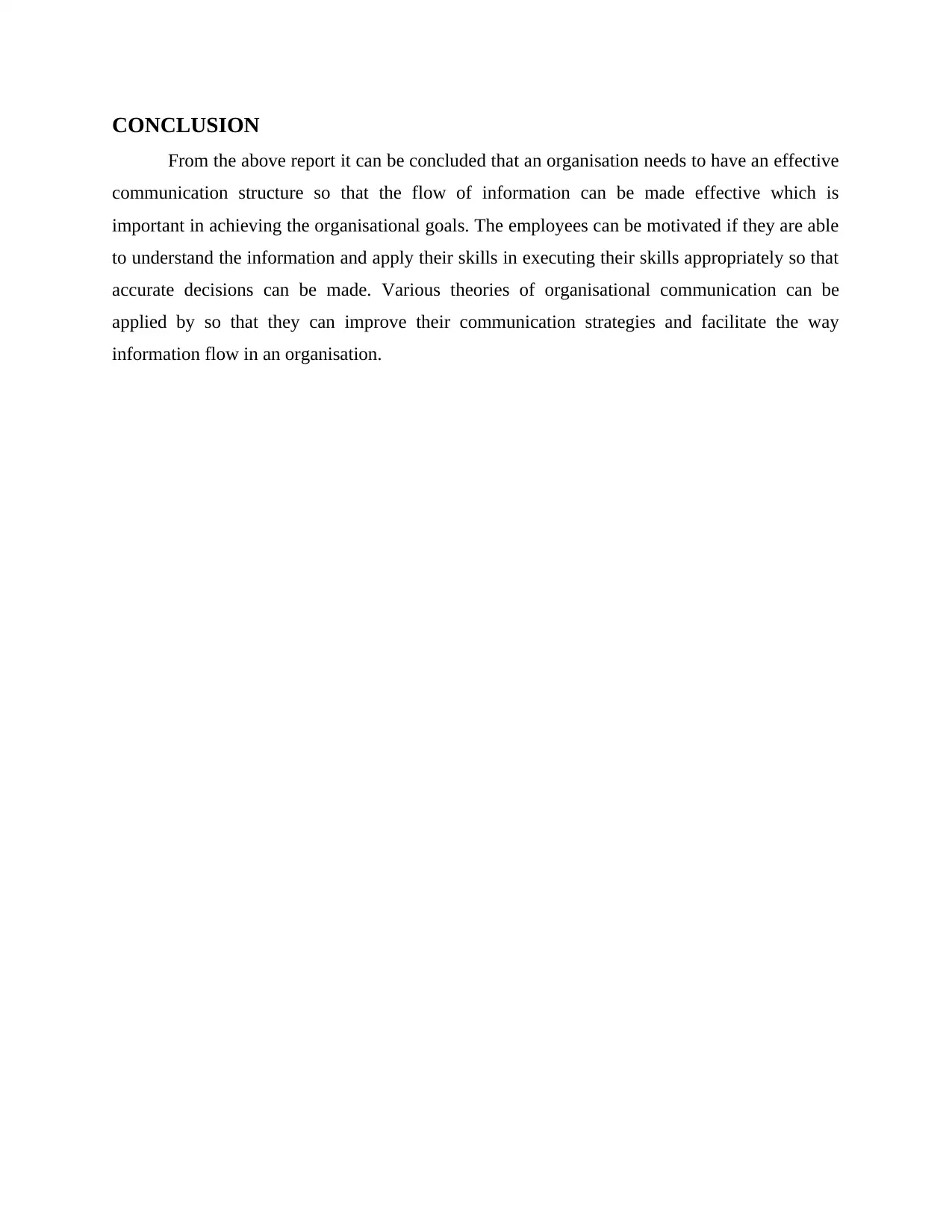
CONCLUSION
From the above report it can be concluded that an organisation needs to have an effective
communication structure so that the flow of information can be made effective which is
important in achieving the organisational goals. The employees can be motivated if they are able
to understand the information and apply their skills in executing their skills appropriately so that
accurate decisions can be made. Various theories of organisational communication can be
applied by so that they can improve their communication strategies and facilitate the way
information flow in an organisation.
From the above report it can be concluded that an organisation needs to have an effective
communication structure so that the flow of information can be made effective which is
important in achieving the organisational goals. The employees can be motivated if they are able
to understand the information and apply their skills in executing their skills appropriately so that
accurate decisions can be made. Various theories of organisational communication can be
applied by so that they can improve their communication strategies and facilitate the way
information flow in an organisation.
Paraphrase This Document
Need a fresh take? Get an instant paraphrase of this document with our AI Paraphraser
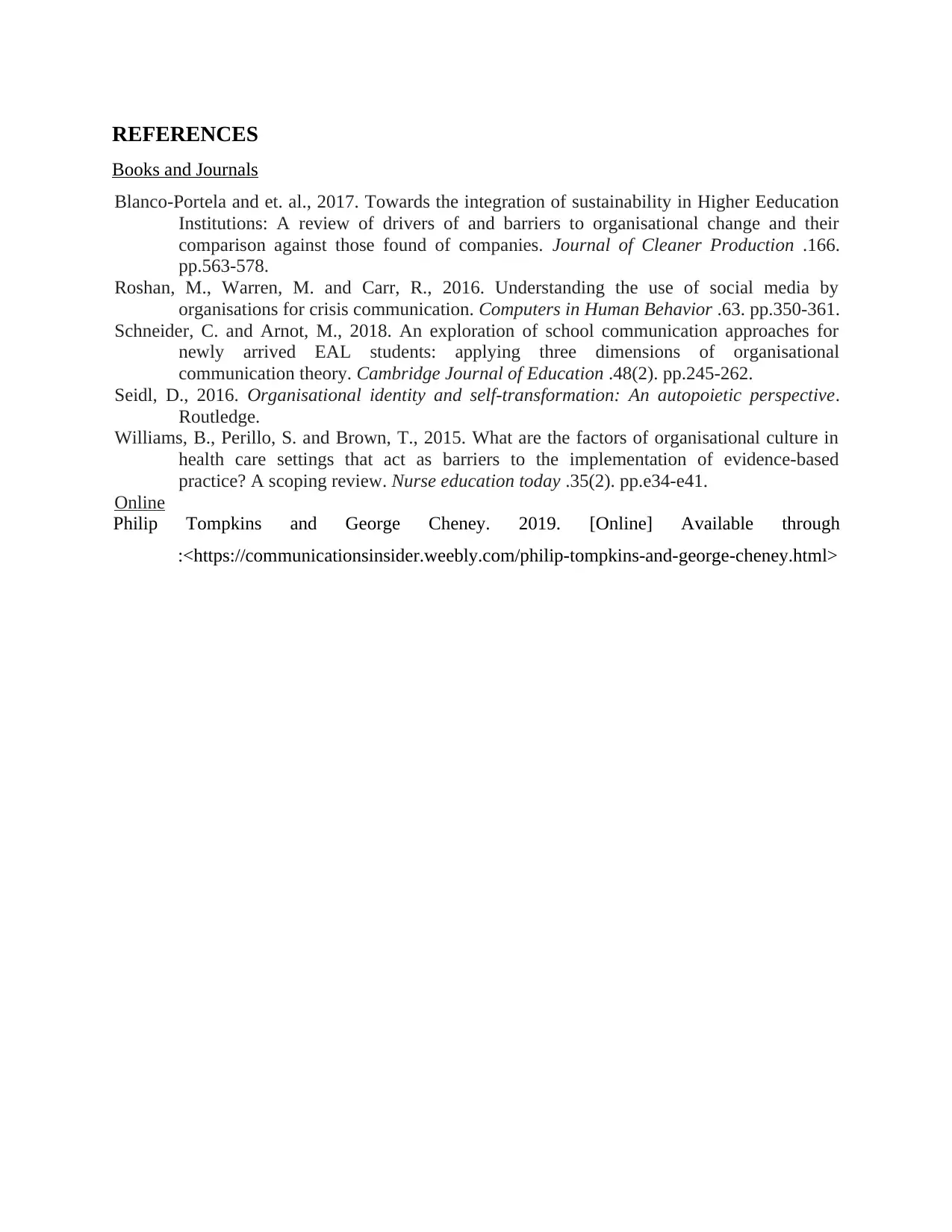
REFERENCES
Books and Journals
Blanco-Portela and et. al., 2017. Towards the integration of sustainability in Higher Eeducation
Institutions: A review of drivers of and barriers to organisational change and their
comparison against those found of companies. Journal of Cleaner Production .166.
pp.563-578.
Roshan, M., Warren, M. and Carr, R., 2016. Understanding the use of social media by
organisations for crisis communication. Computers in Human Behavior .63. pp.350-361.
Schneider, C. and Arnot, M., 2018. An exploration of school communication approaches for
newly arrived EAL students: applying three dimensions of organisational
communication theory. Cambridge Journal of Education .48(2). pp.245-262.
Seidl, D., 2016. Organisational identity and self-transformation: An autopoietic perspective.
Routledge.
Williams, B., Perillo, S. and Brown, T., 2015. What are the factors of organisational culture in
health care settings that act as barriers to the implementation of evidence-based
practice? A scoping review. Nurse education today .35(2). pp.e34-e41.
Online
Philip Tompkins and George Cheney. 2019. [Online] Available through
:<https://communicationsinsider.weebly.com/philip-tompkins-and-george-cheney.html>
Books and Journals
Blanco-Portela and et. al., 2017. Towards the integration of sustainability in Higher Eeducation
Institutions: A review of drivers of and barriers to organisational change and their
comparison against those found of companies. Journal of Cleaner Production .166.
pp.563-578.
Roshan, M., Warren, M. and Carr, R., 2016. Understanding the use of social media by
organisations for crisis communication. Computers in Human Behavior .63. pp.350-361.
Schneider, C. and Arnot, M., 2018. An exploration of school communication approaches for
newly arrived EAL students: applying three dimensions of organisational
communication theory. Cambridge Journal of Education .48(2). pp.245-262.
Seidl, D., 2016. Organisational identity and self-transformation: An autopoietic perspective.
Routledge.
Williams, B., Perillo, S. and Brown, T., 2015. What are the factors of organisational culture in
health care settings that act as barriers to the implementation of evidence-based
practice? A scoping review. Nurse education today .35(2). pp.e34-e41.
Online
Philip Tompkins and George Cheney. 2019. [Online] Available through
:<https://communicationsinsider.weebly.com/philip-tompkins-and-george-cheney.html>
1 out of 8
Related Documents
Your All-in-One AI-Powered Toolkit for Academic Success.
+13062052269
info@desklib.com
Available 24*7 on WhatsApp / Email
![[object Object]](/_next/static/media/star-bottom.7253800d.svg)
Unlock your academic potential
Copyright © 2020–2025 A2Z Services. All Rights Reserved. Developed and managed by ZUCOL.





